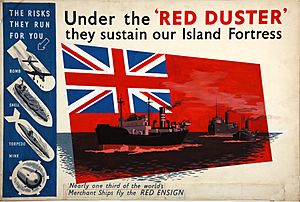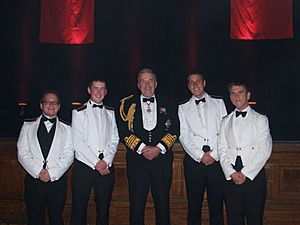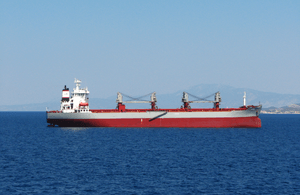Merchant navy facts for kids

A merchant navy or merchant marine is a group of ships that carry goods and sometimes people for a country. These ships are called merchant vessels. The people who work on these ships are called seafarers. They need special documents to show they are trained, as required by an international rule called STCW.
King George V gave the name "Merchant Navy" to the British merchant ships after their brave service in the First World War. Since then, many other countries have started using similar names for their own fleets. This article lists some of these merchant navies from different countries.
Contents
During the First World War, Australia's government used its merchant ships as transport ships, hospital ships, and cargo ships. In World War II, they became hospital ships, supply ships, and even armed ships, especially in the Pacific Ocean.
Since 2008, September 3rd is celebrated as Merchant Navy Day in Australia. On this day, the Australian Red Ensign flag can be flown on land. This special day honors the merchant navy's help during wartime. There is also a memorial in Canberra, Australia's capital, to remember their efforts in both world wars.
The British Merchant Navy includes all the British merchant ships that move goods and people. They do this during times of peace and war.
For a long time, Britain had the biggest merchant fleet in the world. But after the British Empire became smaller in the mid-1900s, its fleet also got smaller. In 1939, the British merchant navy was the largest, carrying 33% of all goods by sea. By 2012, it carried only 3%.
As of 2012, Britain had 1,504 merchant ships that were 100 gross tons or larger. This includes ships owned, partly owned, or managed by British companies. These ships can carry a huge amount of cargo, about 75 million deadweight tons! The UK Chamber of Shipping represents British shipping around the world.
Canada, like other Commonwealth countries, created its own large merchant navy during World War II. It started in 1939 and played a big part in the Battle of the Atlantic. Canadian ships helped the Allies' merchant fleet when many British ships were lost.
Thousands of Canadians worked in the merchant navy on hundreds of Canadian ships. A famous type was the "Park Ship," which was like the American "Liberty Ship." A special school in St. Margarets Bay, Nova Scotia, trained Canadian merchant sailors. "Manning pools," which were like barracks, were built in Canadian ports for these sailors.
Greece's Merchant Marine
The Greek maritime fleet moves goods and services all over the world. It includes merchant ships owned by Greek citizens. These ships fly either the Greek flag or a flag of convenience (a flag from another country).
Greece has a long history with the sea. Shipping has been a key part of Greek life and economy since ancient times. In 2015, the Greek Merchant Marine had the world's largest merchant fleet. They owned 5,226 vessels that could carry over 334 million tons of cargo. Greece is also a leader in owning tankers and bulk carriers.
The modern Indian Merchant Navy began before India became independent from the United Kingdom. This was when the ship SS Loyalty sailed from India to Britain in 1919.
Today, India ranks 15th in the world for how much cargo its ships can carry. India provides a lot of the world's seafarers. About 12.8% of all ship officers and 14.5% of all ratings (other crew members) in the world are from India. This is one of the highest numbers for any country.
India has many well-known merchant shipping companies, such as Shipping Corporation of India and Essar.
In December 1939, New Zealand had 3,000 seafarers and 186 merchant ships. Many larger New Zealand ships were registered in London for insurance reasons. Some foreign ships were also used, like the four-masted sailing ship, Pamir.
New Zealand, like other Commonwealth countries, created a merchant navy. However, the "wartime Merchant Navy was not a military force or one single group." Instead, it was "many different private companies and ships."
While some ships sailed to the Atlantic and North Pacific, most carried goods within New Zealand and the South Pacific. New Zealand-owned ships traded with the United Kingdom, which bought 84% of all New Zealand exports in 1939. Most New Zealand sailors had also served with the British Merchant Navy.
During the war, 64 ships on the New Zealand–UK route were sunk by enemies. 140 merchant seafarers lost their lives, and many others were taken prisoner.
The Pakistan Merchant Navy started in 1947. The government created departments to register ships and make sure they were safe. All the private shipping companies joined together to form the National Shipping Corporation (NSC) and the Pakistan Shipping Corporation (PSC). They then shared a common flag. Some of these companies were the Muhammadi Steamship Company Limited and the East & West Steamship Company.
During the Indo-Pak war of 1971, Pakistan lost many ships. Most Pakistani vessels were left in Bangladesh because their crews spoke Bengali. On January 1, 1974, Pakistan's President Zulfiqar Ali Bhutto took control of the National Shipping Corporation and Pakistan Shipping Corporation. He formed the Pakistan National Shipping Corporation (PNSC) to rebuild Pakistan's Merchant Navy.
Today, the Pakistan National Shipping Corporation is the main shipping company for Pakistan. Its main office is in Karachi. It also has an office in Lahore and many agents around the world to handle its shipping business. The Pakistan National Shipping Corporation also owns several smaller companies.
The Polish Merchant Navy (called Polska Marynarka Handlowa, or PMH in Polish) began when the Second Polish Republic became independent between the two world wars. During World War II, many Polish Navy ships joined the Allied merchant navy and its convoys. This was part of Poland's help in the war.
After the war, the Polish Merchant Navy was controlled by the People's Republic of Poland. After 1989, it came under modern Poland. As of 1999, the PMH had 57 ships that were 1,000 gross tons or larger. These ships could carry over 1.7 million tons of cargo. Most of them were bulk carriers, which carry loose goods like grain or coal. They also had cargo ships, chemical tankers, roll-on/roll-off ships, and passenger ships.
Switzerland's Merchant Marine
Switzerland is a country with no coastline. Yet, it has a fleet of merchant ships that sail the high seas! Their home port is Basel, on the Rhine river. The first ships were bought by the government during World War II. They helped make sure Switzerland got important supplies.
After the war, private companies started their own merchant fleet. The government even helped pay for these ships until 1953. As of 2006, Switzerland had 26 ships, mostly container carriers. These ships could carry over 479,000 tons of cargo and were operated by five shipping companies, all flying the Swiss flag.
United States Merchant Marine
The United States Merchant Marine is made up of civilian-owned merchant ships and government-owned ships. These include ships from the Military Sealift Command, NOAA, Army Corps of Engineers, and Department of Homeland Security. It also includes all the men and women who work on them.
The merchant marine carries cargo and passengers during peacetime. In times of war, it helps the navy. It can be called upon to deliver troops and supplies for the military.
The people in the merchant marine are called "merchant mariners." They are civilians, but during wartime, they are considered military personnel. This is according to the Merchant Marine Act of 1936. As of 2009, the U.S. merchant fleet had 422 ships and about 69,000 people.
This number does not include over 700 ships owned by American companies but registered in other countries. These ships fly a flag from another nation.
See also
 In Spanish: Marina mercante para niños
In Spanish: Marina mercante para niños
- Affreightment
- List of merchant navy capacity by country
- Maritime history
- Maritime flag
- Seafarer's professions and ranks
- Ship transport
- World War II United States Merchant Navy





